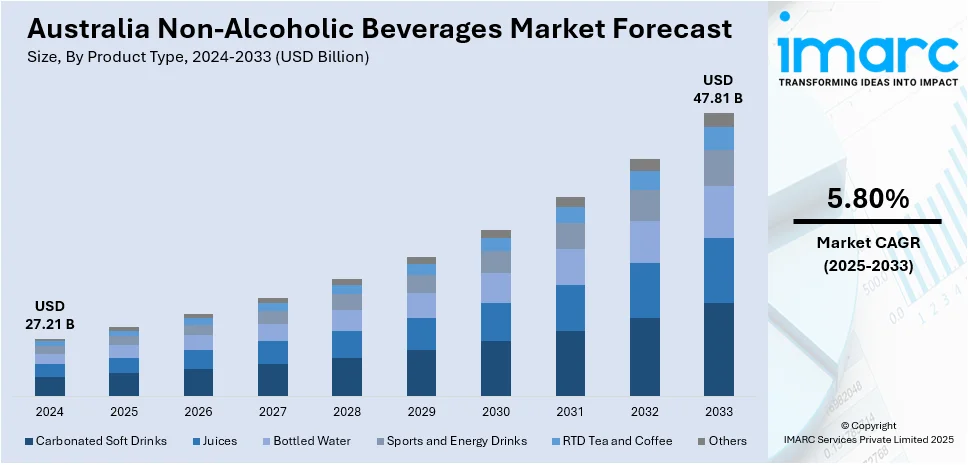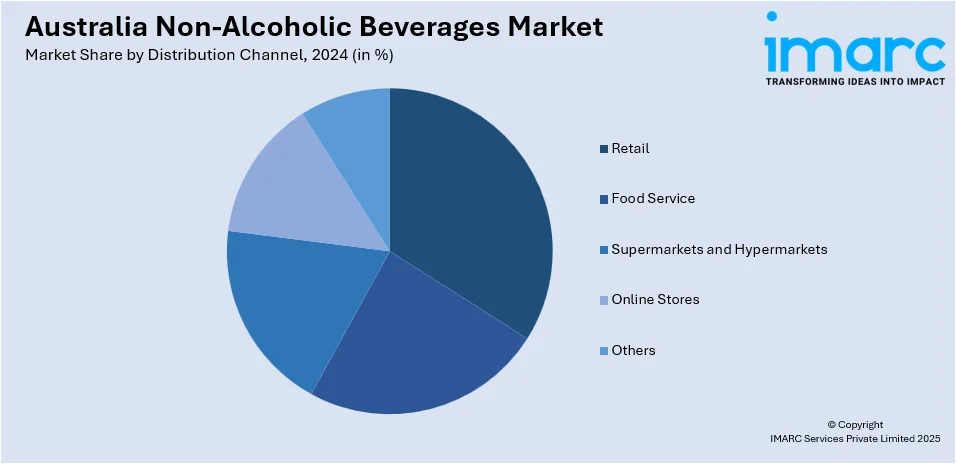
Australia Non-Alcoholic Beverages Market Size, Share, Trends and Forecast by Product Type, Packaging Type, Distribution Channel, and Region, 2025-2033
Australia Non-Alcoholic Beverages Market Overview:
The Australia non-alcoholic beverages market size reached USD 27.21 Billion in 2024. Looking forward, IMARC Group expects the market to reach USD 47.81 Billion by 2033, exhibiting a growth rate (CAGR) of 5.80% during 2025-2033. The market is being driven by increasing health-consciousness, rising demand for low-sugar and functional drinks, a shift towards plant-based alternatives, escalating awareness of wellness, and innovations in product offerings, such as the introduction of flavored water, kombucha, and energy drinks catering to diverse consumer preferences.
|
Report Attribute
|
Key Statistics
|
|---|---|
|
Base Year
|
2024
|
|
Forecast Years
|
2025-2033
|
|
Historical Years
|
2019-2024
|
| Market Size in 2024 | USD 27.21 Billion |
| Market Forecast in 2033 | USD 47.81 Billion |
| Market Growth Rate 2025-2033 | 5.80% |
Australia Non-Alcoholic Beverages Market Trends:
Rising Health Consciousness and Lifestyle Changes
One of the strongest drivers of the Australian non-alcoholic beverages market is the rise in health awareness among consumers. Australians have widely been looking to products that fit into healthier lifestyles in recent years, a trend that has largely been driven by growing awareness of diet-related health concerns such as obesity, diabetes, and heart disease. Customers are actively looking for lower-sugar drinks, natural ingredients, functional attributes, and clean labels. This is particularly common among millennials and Gen Z, who are health-conscious and well-educated on the nutritional value of what they eat and drink. The popularity of non-beverage options, such as flavored water, organic juice, kombucha, and functional beverages containing vitamins, probiotics, and plant extracts, has increased rapidly. Brands are pushing back by innovating with superfoods, adaptogens, and natural sweeteners like stevia or monk fruit. The COVID-19 pandemic also accelerated this trend, as immunity-boosting and mental health-promoting beverages became more popular. Beyond fitness, consumers now see beverages as part of a holistic lifestyle strategy that focuses on mental clarity, physical wellness, and long-term health.

To get more information on this market, Request Sample
Premiumization and Demand for Unique Beverage Experiences
Another impactful driver of the Australian non-alcoholic drinks industry is the propelling demand for premiumization and distinctive consumption experiences. With rising disposable incomes and changing consumer preferences, Australians are no longer looking for drink alone Australians are looking for products that provide sophistication, prestige, and sensory indulgence. The move toward premium non-drinking alternatives manifests in the heightened appeal of artisanal sodas, hand-crafted tonics, plant-burst-infused waters, and booze-free liquor created for the refined palate. The move is not exclusively associated with healthy motives but to the desire to experience luxury and novelty. Consumers are putting investment into unusual flavor profiles, bespoke packaging, artisanship-produced beverages, and limited-run variants. Non-alcoholic cocktails ("mocktails") and alcohol-free beers and wines are now staples in high-end restaurants, fashion bars, and boutique hotels, attracting consumers who desire the social experience of drinking without the intoxicating effects. Storytelling, ingredient provenance, and brand authenticity also come into play, as consumers enjoy stories that link them to craft, heritage, and innovation. This experiential model of non-alcoholic drinks has stretched the market far wider than conventional soft drinks, making it a vibrant space in which indulgence, creativity, and sophistication reframe the Australian drinking culture.
Australia Non-Alcoholic Beverages Market Segmentation:
IMARC Group provides an analysis of the key trends in each segment of the market, along with forecasts at the region/country level for 2025-2033. Our report has categorized the market based on product type, packaging type, and distribution channel.
Product Type Insights:
- Carbonated Soft Drinks
- Juices
- Bottled Water
- Sports and Energy Drinks
- RTD Tea and Coffee
- Others
The report has provided a detailed breakup and analysis of the market based on the product type. This includes carbonated soft drinks, juices, bottled water, sports and energy drinks, RTD tea and coffee, and others.
Packaging Type Insights:
- Bottles
- Cans
- Cartons
- Others
A detailed breakup and analysis of the market based on the packaging type have also been provided in the report. This includes bottles, cans, cartons, and others.
Distribution Channel Insights:

- Retail
- Food Service
- Supermarkets and Hypermarkets
- Online Stores
- Others
The report has provided a detailed breakup and analysis of the market based on the distribution channel. This includes retail, food service, supermarkets and hypermarkets, online stores, and others.
Regional Insights:
- Australia Capital Territory & New South Wales
- Victoria & Tasmania
- Queensland
- Northern Territory & Southern Australia
- Western Australia
The report has also provided a comprehensive analysis of all the major regional markets, which include Australia Capital Territory & New South Wales, Victoria & Tasmania, Queensland, Northern Territory & Southern Australia, and Western Australia.
Competitive Landscape:
The market research report has also provided a comprehensive analysis of the competitive landscape. Competitive analysis such as market structure, key player positioning, top winning strategies, competitive dashboard, and company evaluation quadrant has been covered in the report. Also, detailed profiles of all major companies have been provided, including:
- Altina Drinks
- Asahi Beverages
- Brunswick Aces
- Bundaberg Brewed Drinks
- ETCH Sparkling
- Lyre's Spirit Co
- NON
- Polka
- Sobah Non-Alcoholic Beverages
- Suntory Beverage & Food Australia Pty Ltd
Australia Non-Alcoholic Beverages Market News:
- May 2025: Spinifex Brewing Co and Nexus Airlines partnered to launch a bespoke range of non-alcoholic soft drinks, crafted with native botanicals in collaboration with A Little Wild Australia. Designed for in-flight enjoyment and reflecting Western Australia's unique flavors, these beverages will be available on all Nexus flights from early June and in select regional retail outlets thereafter.
- March 2025: Bundaberg Brewed Drinks, a Queensland-based company, introduced a new low-sugar non-alcoholic beverage range called 'Refreshingly Light'. This line includes flavors such as Raspberry & Pomegranate, Lemon & Watermelon, and Apple & Lychee. Each 250ml can contains only 20 calories and boasts a three-star health rating. Importantly, the drinks contain no artificial sweeteners, colors, or flavors.
Australia Non-Alcoholic Beverages Market Report Coverage:
| Report Features | Details |
|---|---|
| Base Year of the Analysis | 2024 |
| Historical Period | 2019-2024 |
| Forecast Period | 2025-2033 |
| Units | Billion USD |
| Scope of the Report |
Exploration of Historical Trends and Market Outlook, Industry Catalysts and Challenges, Segment-Wise Historical and Future Market Assessment:
|
| Product Types Covered | Carbonated Soft Drinks, Juices, Bottled Water, Sports and Energy Drinks, RTD Tea and Coffee, Others |
| Packaging Types Covered | Bottles, Cans, Cartons, Others |
| Distribution Channels Covered | Retail, Food Service, Supermarkets and Hypermarkets, Online Stores, Others |
| Regions Covered | Australia Capital Territory & New South Wales, Victoria & Tasmania, Queensland, Northern Territory & Southern Australia, Western Australia |
| Companies Covered | Altina Drinks, Asahi Beverages, Brunswick Aces, Bundaberg Brewed Drinks, ETCH Sparkling, Lyre's Spirit Co, NON, Polka, Sobah Non-Alcoholic Beverages, Suntory Beverage & Food Australia Pty Ltd, etc. |
| Customization Scope | 10% Free Customization |
| Post-Sale Analyst Support | 10-12 Weeks |
| Delivery Format | PDF and Excel through Email (We can also provide the editable version of the report in PPT/Word format on special request) |
Key Questions Answered in This Report:
- How has the Australia non-alcoholic beverages market performed so far and how will it perform in the coming years?
- What is the breakup of the Australia non-alcoholic beverages market on the basis of product type?
- What is the breakup of the Australia non-alcoholic beverages market on the basis of packaging type?
- What is the breakup of the Australia non-alcoholic beverages market on the basis of distribution channel?
- What is the breakup of the Australia non-alcoholic beverages market on the basis of region?
- What are the various stages in the value chain of the Australia non-alcoholic beverages market?
- What are the key driving factors and challenges in the Australia non-alcoholic beverages market?
- What is the structure of the Australia non-alcoholic beverages market and who are the key players?
- What is the degree of competition in the Australia non-alcoholic beverages market?
Key Benefits for Stakeholders:
- IMARC’s industry report offers a comprehensive quantitative analysis of various market segments, historical and current market trends, market forecasts, and dynamics of the Australia non-alcoholic beverages market from 2019-2033.
- The research report provides the latest information on the market drivers, challenges, and opportunities in the Australia non-alcoholic beverages market.
- Porter's five forces analysis assist stakeholders in assessing the impact of new entrants, competitive rivalry, supplier power, buyer power, and the threat of substitution. It helps stakeholders to analyze the level of competition within the Australia non-alcoholic beverages industry and its attractiveness.
- Competitive landscape allows stakeholders to understand their competitive environment and provides an insight into the current positions of key players in the market.
Need more help?
- Speak to our experienced analysts for insights on the current market scenarios.
- Include additional segments and countries to customize the report as per your requirement.
- Gain an unparalleled competitive advantage in your domain by understanding how to utilize the report and positively impacting your operations and revenue.
- For further assistance, please connect with our analysts.
 Request Customization
Request Customization
 Speak to an Analyst
Speak to an Analyst
 Request Brochure
Request Brochure
 Inquire Before Buying
Inquire Before Buying




.webp)




.webp)












